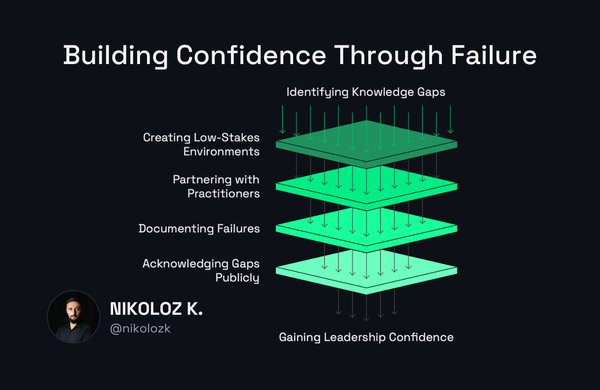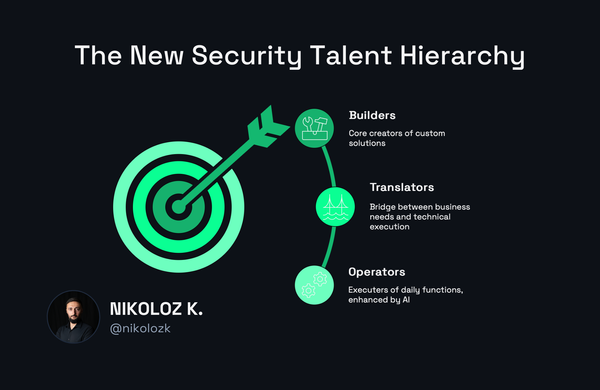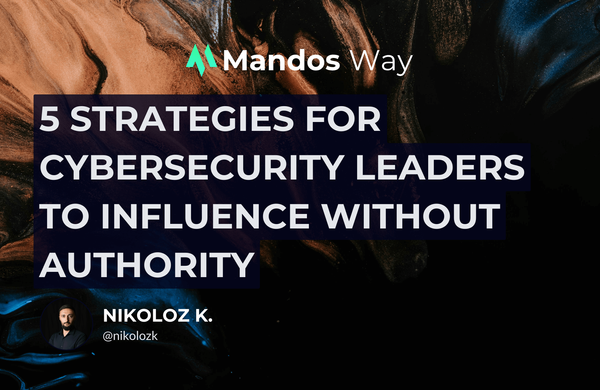How to Transition from a Security Engineer or Analyst to a Strategic Leader

Nikoloz Kokhreidze
Unlock your leadership potential in cybersecurity. Learn to communicate business value, build strategic networks, and embrace mentorship to bridge the gap between technical expertise and executive roles.

Transitioning from a purely technical role in cybersecurity to a leadership position can feel like navigating a digital minefield. We often find ourselves asking, "How do I leverage my technical expertise to lead teams and influence strategic decisions?"
The Leadership Conundrum
Unfortunately, many skilled cybersecurity professionals hit a wall when aiming for management or director roles. We see others with perhaps less technical depth climb the ladder faster, leaving us feeling stuck and undervalued.
Why the Disconnect?
The main culprit? We think, speak, and breathe technology. And while that's essential for our current roles, it can hinder our ability to connect with non-technical decision-makers and articulate the business value of our work.
Consequently, this disconnect is compounded by getting comfortable in our technical echo chambers, missing opportunities to build relationships and understand the needs of other departments.
This disconnect is further exacerbated when we present technical findings without translating them into tangible business outcomes like cost savings, risk mitigation, or revenue opportunities. This inability to effectively communicate the business value of our work often stems from a lack of focus on developing crucial soft skills.
Many cybersecurity professionals often neglect soft skills. We underestimate the importance of communication, negotiation, and people management skills – all crucial for effective leadership. Moreover, we don't actively seek opportunities to lead projects, mentor others, or volunteer for initiatives that showcase our leadership potential.
Charting Your Course to Leadership
Don't worry; the path to leadership is within reach! Here's a roadmap to help you bridge the gap:
Is Security Blocking Your Next Enterprise Deal?
Let's discuss how fractional CISO services can unlock your pipeline without the full-time overhead.
Step 1: Master the Art of Business Communication
Anywhere, anytime communication is everything. Become fluent in "business speak." Instead of drowning executives in technical jargon, learn to frame cybersecurity initiatives in terms of risk management, compliance requirements, financial impact, and brand reputation.
Use analogies heavily. If you cannot explain what you are doing and why to a 5-year-old, you will fail to become a good business communicator. Why? Because you cannot expect your business peers or even other tech departments to know the cybersecurity or technologies you are dealing with.
Effective communication is crucial for gaining buy-in for your ideas and securing budget for your projects. To achieve this, you need to speak the language of business leaders. They need to understand how your work contributes to the organization's bottom line.
To illustrate this point, consider the analogy of car insurance: Most people pay for car insurance even though they don't expect to be involved in a crash. They do so because the potential financial impact of an accident without insurance is too high. Similarly, investing in cybersecurity measures, such as employee training and advanced threat detection systems, helps protect the organization from the potentially devastating consequences of a data breach, even if the likelihood of an attack seems low.
Step 2: Build a Strategic Network (Inside and Out)
Another important tool you should rely on when aiming to transition into a leadership role is expanding your network beyond the cybersecurity realm. Connect with colleagues in other departments, attend industry events, and engage with thought leaders online.
In my experience it's essential to avoid the common pitfall of sticking to your comfort zone and networking only with other cybersecurity professionals.
To break out of your comfort zone, make a conscious effort to attend cross-functional meetings, participate in company social events, and reach out to people in different roles for informational interviews. By engaging with professionals outside your immediate field, you can gain valuable perspectives and insights.
A diverse network provides valuable insights into different business functions, helps you identify potential security risks and opportunities, and raises your profile within the organization. Building connections across various departments and industries will not only enhance your understanding of the business as a whole but also position you as a well-rounded and strategic leader.
Step 3: Become a Sought-After Mentor (and Seek Mentorship)
I always say that strong leaders are good followers and supportive mentors. Offer your expertise to mentor junior colleagues and actively seek out mentors who can provide guidance and support.
In fact, mentorship is a powerful tool for both personal and professional growth. It helps you develop leadership skills, build strong relationships, and gain valuable insights from experienced professionals. It also keeps you grounded in what is happening in the trenches. Engaging in mentorship relationships can help you cultivate essential skills that will serve you throughout your career.
By mentoring others, you'll hone your communication and coaching abilities. By having mentors, you'll gain valuable perspectives, advice, and advocacy as you navigate your career journey. These experiences will shape you into a well-rounded professional and leader.
Is Security Blocking Your Next Enterprise Deal?
Let's discuss how fractional CISO services can unlock your pipeline without the full-time overhead.
Remember, Leadership is Not a Title, It's a Mindset
Throughout my career, I have seen strong leaders who were security engineers and analysts, and I have seen CISOs who were weak leaders. Leadership is not about a title; it's about inspiring others, aligning cybersecurity with business goals, and continuously learning and adapting. Adopting a leadership mindset involves embracing the journey of personal and professional growth.
As you cultivate your leadership mindset, you'll find that the journey is filled with opportunities to learn, adapt, and make a meaningful impact in the cybersecurity field. By continuously seeking knowledge, collaborating with others, and aligning your efforts with organizational objectives, you'll develop the skills and confidence needed to become an effective leader.
Leadership is not a destination but a continuous process of growth and development. Stay committed to your personal and professional growth.
Before you go
If you found this article useful, I'd really appreciate if you could forward it to your community and share your feedback below!
For more frequent cybersecurity leadership insights and tips, follow me on LinkedIn, BlueSky and Mastodon.
Best,
Nikoloz



